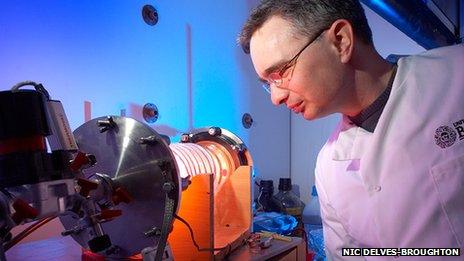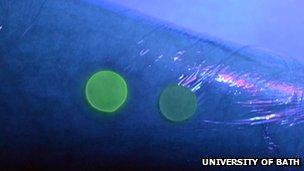Burn dressing 'lights up' to signal an infection
- Published

The dressing, developed by scientists at the University of Bath, uses nanocapsules which contain a fluorescent dye
Scientists have developed a medical dressing that 'lights up' when a burn is infected.
It could be lifesaving in young children with serious burns in whom infections can rapidly become fatal, the Bath researchers said.
A prototype dressing, which glows under UV light when it detects harmful bacteria, is featured on BBC science show Bang Goes the Theory.
But trials in humans are still some years away.
Fast diagnosis of infection in children with burns, such as those caused by scalds from hot drinks, is a big problem for clinicians, the researchers said.
Current tests for an infected wound can take up to a couple of days but children - especially those of pre-school age - are particularly at risk from the effects of infection due to their relatively poor immunity.
They can quickly develop a condition called toxic shock syndrome, which if left untreated can be fatal in half of cases.
Fluorescent dye
The dressing developed by scientists at the University of Bath uses nanocapsules containing a dye that burst open in the presence of disease-causing bacteria.
Using a UV light, doctors can quickly check whether there is infection by seeing if the dressing glows.
The nanocapsules are activated when they come into contact with toxins produced by harmful bacteria, so do not release the dye in response to normal bacteria that live on the skin.
So far the dressing has been tested on skin samples in the laboratory.

How the fluorescent dye would look on an arm burn if it was infected - the right one is not infected
Dr Toby Jenkins, reader in Biophysical Chemistry at Bath, and project lead said about 5,000 children a year in England and Wales are treated in hospital for burns.
"The big problem for clinicians is the fast diagnosis of infection. Current methods take between 24 and 48 hours to get an answer as to whether the wound is infected.
"However, our burns dressing gives a simple colour change under UV light if a pathogenic, disease-causing bacteria is present in the burn, meaning clinicians can be alerted quickly to a potential infection."
Dr Amber Young, consultant paediatric anaesthetist at the South West Paediatric Burns Centre at Frenchay Hospital in Bristol and clinical adviser to the project said when a child with a small burn develops a high temperature there is no easy way of knowing if the child has a serious bacterial infection, or simply a cough or cold.
"We currently have to remove the dressing to test for infection, which may result in slower healing and potentially life-long scarring and is very distressing for the child.
"This new dressing will mean we will be able to detect the early signs of infection so we can diagnose and treat the child quickly."
Prof Sheila MacNeil, from Sheffield University, said the technology was based on two clever concepts - that it only reacts in the presence of life-threatening bacteria and that the florescent dye only shows up once the nanocapsules have burst.
"It has been developed for use in paediatrics but it could also be useful in lots of other contexts, such as the management of chronic ulcers in the home," she added.
Bang Goes The Theory is broadcast on Monday 25 March, at 19:30pm on BBC One.
- Published16 September 2011
- Published31 January 2011
- Published8 July 2010